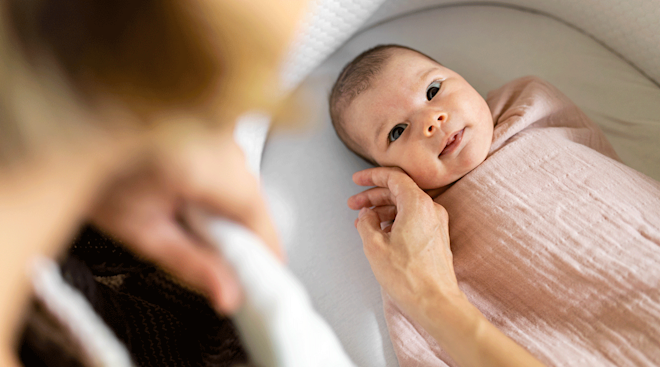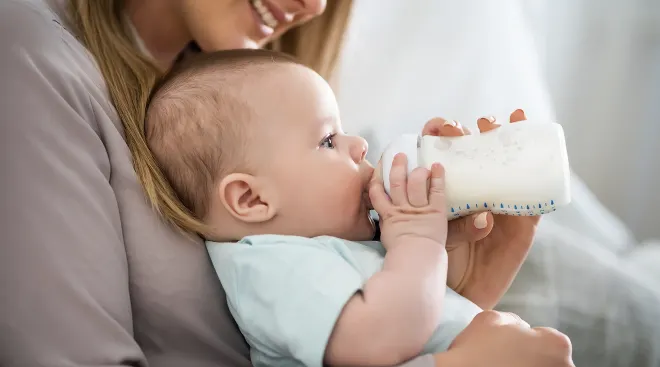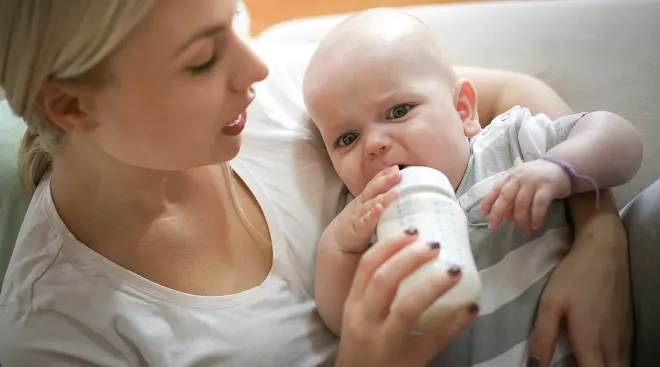Why Bottle Propping Is a Big Feeding No No
Feeding time can be a sweet bonding experience, offering you a few moments of calm during the hectic day. But let’s be honest: bottle feeding can also feel tiring and tedious after a while, especially when your little one is on a schedule where they’re eating every couple of hours. For bleary-eyed parents, bottle propping—which basically means using something to keep the bottle positioned in baby’s mouth—may sound like a smart time-saving idea. After all, hands-free feeding could enable you to get something else done while baby’s happily eating. It sounds great in theory, but the truth is that bottle propping is never safe in practice. Read on to find out why you should avoid bottle propping, plus important bottle-feeding tips to keep top of mind.
Bottle feeding typically means holding baby while also holding their bottle as they drink from it. Bottle propping means you’re using something else to hold the bottle up rather than your own hands. “This allows baby to feed without the direct involvement of a caregiver,” says Joel “Gator” Warsh, board-certified pediatrician and author of the book Parenting at Your Child’s Pace. “In this scenario, the infant lies down while the bottle remains accessible for independent feeding.”
According to Gator, bottle proppers can include almost any basic household item, including pillows or blankets. In short, many parents will simply grab something nearby that will effectively secure the bottle in place. Of course, there are some bottle holders you can find online, which are specifically meant to prop bottles while babies are eating.
You can’t blame parents and caregivers for wanting to give bottle propping a try—everyone needs a break from time to time. Unfortunately, bottle propping is dangerous and highly discouraged by pediatricians.
Bottle propping typically means that baby is left to drink on their own, whether you’re by their side absorbed in your own activity or in a nearby room—and this can lead to all sorts of scary problems.
“When left unsupervised, babies face an increased likelihood of severe health complications,” Gator says. “Bottle propping can result in choking, ear infections and dental issues, since infants are unable to regulate milk flow or discontinue feeding when necessary.” Both the American Academy of Pediatrics (AAP) and the Centers for Disease Control and Prevention (CDC) recommend against bottle propping as well. In addition to the aforementioned risks, the CDC notes that bottle propping can also lead to baby eating more than they need.
Additionally, Robert Quillin, MD, board-certified pediatrician and medical director at Pediatrix points out that bottle propping also means you’re missing out on the parent-child interaction comes with feeding baby.
According to Quillin, there are no safe ways to prop baby’s bottle. Bottle feeding should always entail you holding the bottle for baby as they drink so that you can keep a close eye on how much they’re taking in and if they need a break.
That said, there are ways to make bottle feeding a bit easier and more manageable. Gator recommends trying paced bottle feeding. “This techniques allow babies to manage the flow and take breaks as needed,” he says. Basically, you can help slow the flow of milk into the nipple and the mouth and also take breaks to encourage slow eating.
Additionally, Gator suggests using a nursing pillow for extra support This doesn’t mean propping the bottle on the pillow, it means adding extra support for you and your little one with a pillow so you’re both more comfortable.
Believe it or not, the day will come when baby starts holding their own bottle and becomes a bit more independent during feedings. While babies can begin to grasp as early as 2 to 4 months, Quillin notes that they likely won’t be able to hold their own bottle until they’re between 6 to 10 months olds.
There are a few ways to know your little one is ready to start holding their own bottle. One sign is that they’re able to grasp and hold other large objects on their own. “Indicators of readiness include proficient hand-eye coordination, ability to sit independently and reaching for the bottle on their own,” Gator says. He also notes that it’s something you need to be patient about: “It’s essential for parents to encourage this skill development naturally rather than pushing it prematurely.”
Bottle feeding sessions should ideally be calm and peaceful for you and baby. And you’ll want to take some safety tips into consideration.
Always supervise feeding sessions
“Never leave an infant unattended with a bottle,” Gator urges. “Supervision is crucial even if they can hold the bottle themselves.”
Maintain an upright positioning
When feeding, be sure to prop baby up a bit so they’re in an almost seated position rather than letting them lie down. “Keeping babies upright aids in digestion and minimizes risks related to choking and ear infections,” Gator points out. You should also hold the bottle in an upright position that allows for regulated milk flow.
Give them breaks as needed
Practice paced feeding techniques, like slowing down the flow of milk into their mouth and taking frequent breaks throughout the feeding session. You may need to pull the nipple out of their mouth even if they don’t seem happy about it. This gives them time to digest and feel full.
Always monitor and check the temperature of the milk
Unless you’re using freshly expressed breast milk, you should always test the temperature of milk before giving it to your baby. Quillin also cautions against microwaving milk: “The contents of the bottle should be warmed slowly to the temperature that’s appropriate for the infant to feed, which is 98.6 degrees.” He notes that you can test the temperature by putting a drop of milk on your wrist. It should feel warm but not hot.
Burp them throughout
Don’t wait until the end of the feeding session to burp baby. Gator recommends regular burping intervals throughout the session and after to alleviate gas discomfort.
Make sure the nipple is the right size
The AAP stresses the importance of using the correct bottle nipple hole size. You’ll know it’s too big if baby seems to be gagging or gulping too fast. If the hole is too small, you’ll notice baby sucking hard and getting frustrated. There’s no one correct size; instead, play around with different sizes to find what works best for your little one.
Don’t let them fall asleep while feeding
According to the AAP, you shouldn’t let baby fall asleep while drinking a bottle of milk, especially if they’re cutting teeth. Leaving milk in baby’s mouth can cause serious tooth decay, and any milk residue left behind should always be gently wiped from the gums.
As convenient as bottle propping sounds, the risks are real. So for now—keep your eye on the prize (that’s baby!) and your hands on their bottle.
Please note: The Bump and the materials and information it contains are not intended to, and do not constitute, medical or other health advice or diagnosis and should not be used as such. You should always consult with a qualified physician or health professional about your specific circumstances.
Plus, more from The Bump:
Robert Quillin, MD, is a board-certified pediatrician and medical director at Pediatrix in Texas. He earned his medical degree from the University of Texas Medical Branch in Galveston, Texas.
Joel “Gator” Warsh, is a board-certified pediatrician and author of the book Parenting at Your Child’s Pace. He earned his medical degree from Thomas Jefferson Medical College, and completed his pediatric medicine training at Children’s Hospital of Los Angeles (CHLA) before founding his current practice, Integrative Pediatrics and Medicine Studio City.
American Academy of Pediatrics (AAP), Practical Bottle Feeding Tips, December 2011
Centers for Disease Control and Prevention (CDC), Bottle Feeding
Learn how we ensure the accuracy of our content through our editorial and medical review process.
Navigate forward to interact with the calendar and select a date. Press the question mark key to get the keyboard shortcuts for changing dates.



















































